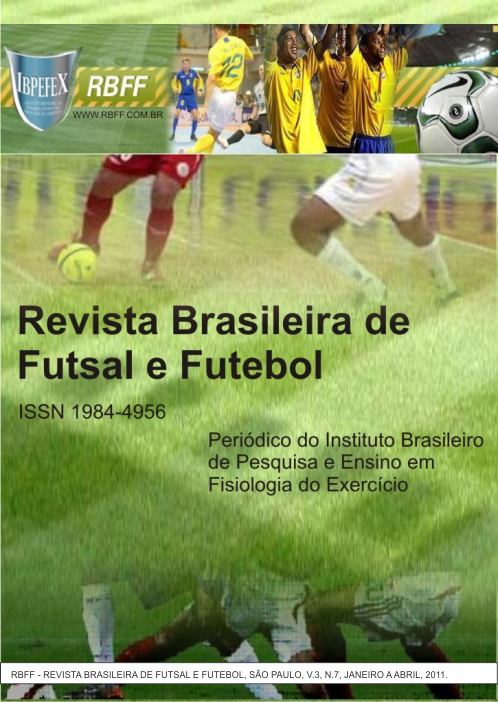Confronto tra il test di Cooper e il test di resistenza yoyo L1 per la previsione del VO2 max nei calciatori dilettanti under 15
Abstract
Obiettivo: Questo studio ha eccelso nel confronto e nella correlazione tra Cooper Tests (TC) e Yoyo Endurance Test L1 (YETL1) al fine di prevedere il volume massimo di ossigeno relativo alla massa corporea (Vo2 max. ml/kg/min.), osservando per identificare il test più adatto per calciatori under 15. Materiali e metodo: 8 soggetti maschi (n = 8) hanno partecipato volontariamente a questo studio, con un'età media di 14,88 (±0,35) anni, altezza media 173, 98 cm (±6,36) e massa corporea media di 72 kg (±5,39), apparentemente sana. Gli atleti sono stati sottoposti a due prove in campo per la previsione del Vo2 max., ovvero il TC e lo YETL1. I risultati sono stati analizzati dalla statistica parametrica dei test di correlazione di Pearson (r) e confrontati dal rapporto tra i gruppi. Con un margine di errore P<0,05 adottato per l'area sanitaria. Risultati: I valori di Vo2 max. ha indicato una media di 44,00 ml/kg/min. (± 4,60) per CT. YETL1 ha mostrato 56,91 ml/kg/min. (±3,41). La correlazione era r = 0,71. La frequenza cardiaca ha indicato una media di 157,13 (± 20,14) battiti al minuto (bpm) per CT e 181,88 (± 7,85) bpm per YETL1, con indice di correlazione r = -0,08. Tuttavia, per quanto riguarda il rapporto della media dei test, pari a 0,86, può ritenersi rilevante. Discussione: La correlazione per Vo2 max. r = 0,71 era significativo e il rapporto 0,77 era rilevante, confermando i dati. La correlazione per HR era r = -0,08, quindi negativa per la correlazione tra i test, tuttavia il rapporto di 0,86 indicava rilevanza per i risultati. Conclusione: i valori di Vo2 max. indicare la correlazione tra TC e YETL1. Per quanto riguarda la frequenza cardiaca, non c'era correlazione tra i test. In tutte le valutazioni, i risultati di Cooper erano inferiori rispetto a YETL1, suggerendo il secondo protocollo più adatto per misurare il Vo2 max. in under 15 calciatori e quindi prescrivere allenamento.
Riferimenti bibliografici
-Barros, TL.; Guerra, I. Ciência do Futebol. Barueri. Manole. 2004.
-Cabral, C.P. História do Futebol Mundial. São Paulo. São Leopoldina. 1978.
-Cooper, K. Correlations Between Field and Treadmill Testing as a Means for Assessing maximal Oxygen Intake. JAMA.1968. p. 201-203.
-Costa Junior, D.; Tourinho, P.M.; Vieira, G.C.F.; Melo, L.V.; Boligan, T.C.O.; Figueiredo, P.R.C. Comparação do consumo de máximo de oxigênio por posição técnico-tática de futebolistas da categoria juvenil. Revista de Educação Física. 14º SIAFis. Num. 149. 2010. p. 25.
-Dantas, E. H. M. A Prática da Preparação Física. 5° Edição. Rio de Janeiro. Shape. 2003.
-Duarte, O. Enciclopédia Todas as Copas do Mundo. São Paulo. Makron Books. 1998.
-Franciscon, M. Futebol Regras e Legislação. São Paulo. 2003.
-Frisselli,A.; Mantovani, M. Futebol Teoria e Prática. São Paulo. Phorte. 1999.
-Garret Júnior, W. E.; Kirkendall, D.T. A Ciência da Educação e dos Esportes. Porto Alegre. Artmed. 2003.
-Grorayeb, N.; Barros, T.L. O Exercício. São Paulo. Atheneu. 2004.
-Mcardle, W.D.; Katch, F.I.; Katch, V.L. Fisiologia Humana: Energia, Nutrição e Desempenho Humano. Guanabara Koogan.4ª edição. Rio de Janeiro. 1998.
-Mahseredjian, F.; Barros Neto, T.L.; Tebexreni, A.S. Estudo Comparativo de Métodos para Predição do Consumo Máximo de Oxigênio e Limiar Anaeróbio em Atletas. Revista Brasileira de Medicina do Esporte. Niterói. Vol. 5. Num. 5. 1999.
-O’Donnell, C.; Smith, D. A.; O’Donnell, T. V.; Stacy, R. J. Physical Fitness of New Zealand Army Personnel, Correlation Between Field Tests and Direct Laboratory Assessmentes, Anaerobic Theshold and Maximum Oxygen Uptake. New Zealand. Vol. 97. Num. 760.
-Oliveira, N. A história de Todas as Copas do Mundo de Futebol (1930/1934). São Paulo. Lisa. 1995.
-Pereira L. N.; Monteiro, A. N.; Franca Junior, E. G.; Pereira, R.; Machado, M. Correlação entre o Vo2 max. Estimado pelo Teste de Cooper de 12 minutos e pelo Yoyo Endurance Test L1em atletas de Futebol. Revista Brasileira de Futebol. Vol. 1. Num. 1. 2008. p. 33-41.
-Pitanga, F. J. G.; Testes, Medidas e Avaliações em Educação Física e Esportes. 5° Edição. São Paulo. Phorte. 2008.
-Rio, J.P.A.G.; Estudo de Correlação entre o Yoyo Intermitente Endurance Test e Cooper Test com Jovens Basquetebolistas e Futebolistas. Faculdade de Desporto Universidade do Porto. Porto, Portugal. 2009.
-Santos, P.J.; Soares, J.M. Capacidade Aeróbia em Futebolistas de Elite em Função da Posição Específica no Jogo. Faculdade de Ciências do Desporto e de Educação Física Universidade do Porto. Porto, Portugal. Vol. 1. Num. 2. p. 7-12.
-Silva, O.B.; Saraiva, L.C.R.; Sobral Filho, D.C. Teste Ergométrico em Crianças e Adolescentes: Maior Tolerância ao Esforço com Protocolo em Rampa. Arquivos Brasileiros de Cardiologia. Vol. 89. Num. 6. p. 391-397. 2007.
-Simplício, B.; Peixoto, R.; Melser, T; Abrantes, R.; Assis, M. Análise da Resistência Aeróbia de Futebolistas das Categorias Pré-Mirim, Mirim, Infantil, Juvenil e Junior. Revista de Educação Física. Rio de Janeiro. 14º SIAFis. Num. 149. 2010. p. 16.
-Viana. A. R. e colaboradores. Futebol. Rio de Janeiro. Sprint.1987.
-Weineck, J. Futebol Total: o Treinamento Físico no Futebol. Guarulhos. Phorte. 2000.
Gli autori che pubblicano in questa rivista accettano i seguenti termini:
- Gli autori conservano il diritto d'autore e concedono alla rivista il diritto di prima pubblicazione, con l'opera contemporaneamente concessa in licenza ai sensi del Creative Commons Attribution License BY-NC quello che consente la condivisione dell'opera con riconoscimento della paternità dell'opera e prima pubblicazione in questa rivista.
- Gli autori sono autorizzati a stipulare separatamente ulteriori contratti, per la distribuzione non esclusiva della versione dell'opera pubblicata su questa rivista (es. pubblicazione in un repository istituzionale o come capitolo di libro), con riconoscimento della paternità e prima pubblicazione in questa rivista .
- Gli autori sono autorizzati e incoraggiati a pubblicare e distribuire il proprio lavoro online (ad es. in archivi istituzionali o sulla propria pagina personale) in qualsiasi momento prima o durante il processo editoriale, in quanto ciò può generare cambiamenti produttivi nonché aumentare l'impatto e la citazione del pubblicato lavoro (Vedi O Efeito do Acesso Livre).





